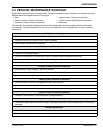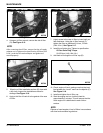
OPERATION
22 Operation TP-6901 6/14
4.6 MONITORING ENGINE
OPERATION
Check for the following items as the engine runs.
• Gas/air leaks: check for leakage from fuel pipes,
cooling pipes, or air pipes.
• Exhaust: check for detonation, backfire, or
knocking. Watch for excessive smoke or abnormal
color.
• Noise: listen for rattles or other abnormal noise.
• Electrical: check for burnt smell from hot electrical
equipment.
• Fluid leaks: check for leaking oil or coolant.
• Gauges: check oil pressure, coolant temperature,
and other operating parameters.
If any abnormal or unusual conditions are detected,
stop the engine immediately and perform
troubleshooting diagnostics before resuming operation.
4.7 STOPPING
1. Disconnect all applied loads if possible, along with
Power Take-Off (PTO) attachments, before
stopping the engine.
2. If the engine has been running under a heavy load,
reduce engine speed and allow it to run for an
additional 2–3 minutes before stopping. This action
will help to cool the engine slightly before
shutdown.
The specific engine-stopping sequence varies
depending on the equipment that this engine powers.
Refer to your equipment Operation Manual for more
information.
WARNING
!
Carbon monoxide can cause
severe nausea, fainting, or death.
Avoid inhaling exhaust fumes.
Engine exhaust gases contain poisonous carbon
monoxide. Carbon monoxide is odorless, colorless,
and can cause death if inhaled.
!
CAUTION
Electrical shock can cause injury.
Do not touch wires while engine is
running.


















